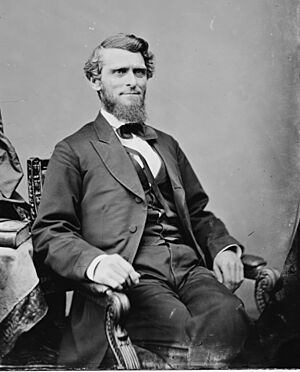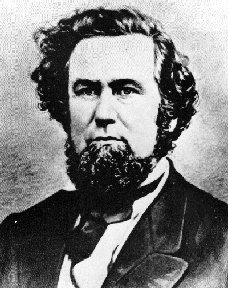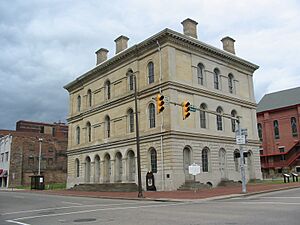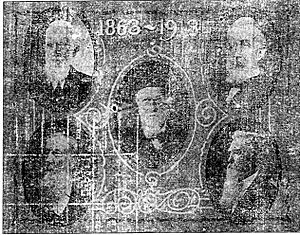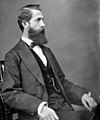Wheeling Convention facts for kids
The Wheeling Convention was a series of important meetings held in 1861 in Wheeling, Virginia. People from the western parts of Virginia gathered because they did not agree with Virginia leaving the United States to join the Confederacy. Their main goal was to stop Virginia's decision to secede (leave the Union).
These meetings happened in two main parts. The first meeting took place before people in Virginia voted on whether to leave the Union. Some people wanted to act right away, but most decided to wait for the vote. When the vote showed that Virginia would leave, the second meeting happened. During this second meeting, the delegates created their own government, called the Restored Government of Virginia. The United States government recognized this new government. This allowed them to start the process of creating a new state, which would become West Virginia.
Contents
First Wheeling Convention: What Happened First?
The First Wheeling Convention was held from May 13 to May 15, 1861. People from 27 counties in northwestern Virginia attended. Many of the 429 delegates were from the area around Wheeling. Some were chosen by their communities, while others came on their own. William B. Zinn, who had served in the Virginia government many times, was chosen to lead the meeting.
Right away, there was a big discussion about who should be allowed to participate. Some, like Gen. John Jay Jackson, thought all people from northwestern Virginia should join. But John S. Carlile believed only those officially chosen by their areas should be there. They decided to create a committee to figure this out.
A big debate was whether to act immediately against Virginia's decision to secede. The vote on secession was not until May 23. Some, like Jackson, thought it was too soon to act before the official vote. Others, like Carlile, wanted to act right away to show their loyalty to both Virginia and the United States. Carlile even suggested creating a new state called "New Virginia."
However, Waitman T. Willey said Carlile's idea was "triple treason" because it went against Virginia, the U.S., and the Confederacy. Most people at the convention decided against Carlile's immediate plan. Instead, they agreed to elect delegates for a Second Wheeling Convention. This next meeting would happen on June 11, but only if the people of Virginia voted to approve the Ordinance of Secession.
Second Wheeling Convention: Forming a New Government
Who Attended the Second Convention?
The Second Wheeling Convention included people from 32 western counties, plus delegates from Alexandria and Fairfax County. Many of these delegates were already members of the Virginia General Assembly, like John J. Davis and Lewis Ruffner.
Arthur I. Boreman was chosen to be the president of this convention. He clearly stated their goal: "We are determined to live under a state government in the United States of America and under the Constitution of the United States." This meant they wanted to stay part of the USA.
Counties that supported the Confederacy either did not send representatives or were not allowed to have seats. For example, Greenbrier County did not send a delegate. Its representative, Mason Mathews, instead attended the Virginia General Assembly in Confederate Richmond.
Many delegates at the convention felt that the differences between eastern and western Virginia were too big to fix. They supported some kind of separation. The main disagreement was about how this separation should happen. Dennis Dorsey wanted a complete and permanent split from eastern Virginia. Carlile, however, convinced the delegates that they first needed to form a loyal government for Virginia. This new government could then give permission for a new state to be created.
Important Discussions and Debates
John S. Carlile was a key leader at the Second Wheeling Convention. He helped guide the creation of the Restored Virginia Government. On June 14, he explained his views on how state and federal governments relate. He said that the people of Virginia created two main "agents" for governing: the Federal Government and the State Government.
Carlile pointed out that the U.S. Constitution says that any state action that goes against the Federal Government's powers is invalid. He quoted Henry Clay, who said, "I owe a supreme allegiance to the Federal Government, a subordinate one to my own State." Carlile argued that the Constitution has ways to change itself, but it was never meant for states to simply leave the Union.
|
On June 17, Carlile strongly criticized the rebellion, calling it "treason." He said it was a carefully planned effort to destroy constitutional freedom in the country. He described how the secession movement was full of lies and threats. Carlile talked about what happened at the Richmond Secession Convention. He said that before the vote to secede, the convention was surrounded by angry mobs. Members were threatened, and there was a lot of fear.
Carlile also questioned the fairness of Virginia's vote on secession. He claimed that a "reign of terror" began in every county after the secession vote. He said that "committees of safety" told Union supporters they had to leave the state. Union men were warned they would be charged with treason. Carlile described how troops from other Southern states were present during the election. He said that in many areas, people could not vote freely. He stated that voting against secession put their lives at risk. He concluded that the secession was carried out through "treason."
What Were the Results of the Convention?
On June 13, Carlile presented a document called "A Declaration of the People of Virginia." This document stated that any major change to the state government needed to be approved by a public vote. Since the Secession Convention was not called by a public vote, all its actions, including the Ordinance of Secession, were illegal. The document also declared the existing government in Richmond invalid. It called for a new state government to be formed. On June 19, the delegates all agreed to this plan.
The very next day, June 20, the convention chose new leaders for the Virginia state government. This new government is usually called the Restored Government of Virginia. Francis Harrison Pierpont was elected as the new governor. The convention then took a break until August 6.
|
Archives: How We Know What Happened
The details of the First Wheeling Convention were written down by Judge Gibson Lamb Cranmer and others. Judge Cranmer was also the Secretary for the Second Wheeling Convention. He was in charge of all the written records and documents. However, his records were lost during a big flood in Wheeling in 1884.
People tried to find copies of the records in other cities like Alexandria and Richmond, but they couldn't find any. Later, Virgil A. Lewis, who was the State Historian of West Virginia, put the records back together. He used daily reports that were printed in the Wheeling Daily Intelligencer newspaper. These reconstructed records were published in a book called How West Virginia Was Made in 1909.


